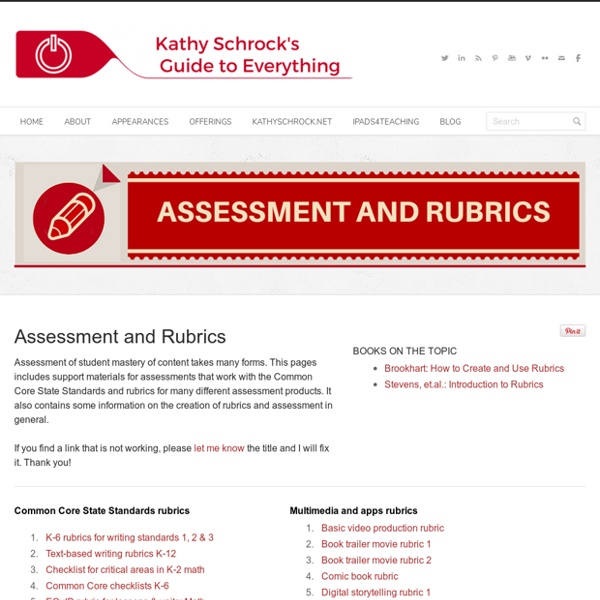



http://www.schrockguide.net/assessment-and-rubrics.html
Related: rubricas • ammmi • Resources • Assessment • Assessment for LearningWomen Against Feminism Women Against Feminism Thousands of photos since July 2013 Oct 3, 2017 / 77 notes 1. 34 Strategies For The Stages Of Assessment: Before, During & After - 34 Strategies For The Stages Of Assessment: Before, During & After by TeachThought Staff For professional development on assessment, contact us today. The follow graphic from the infographic-famous Mia MacMeekin offers 34 strategies for each stage of the assessment process–before, during, and after. Rather than simply repeat them from the graphic, we’ve give a quick primer on the differences between each stage in terms of its purpose/function in the learning process. Take to the comments with any strategies you find useful in your classroom, and give Mia a follow on twitter and say hello!
Fantastic Comprehensive List of Assessment Tools for Teachers About ETR Community EdTechReview (ETR) is a community of and for everyone involved in education technology to connect and collaborate both online and offline to discover, learn, utilize and share about the best ways technology can improve learning, teaching, and leading in the 21st century. EdTechReview spreads awareness on education technology and its role in 21st century education through best research and practices of using technology in education, and by facilitating events, training, professional development, and consultation in its adoption and implementation.
The Teacher’s Guide to Using YouTube in the Classroom YouTube is one of the most popular websites on the planet and a vast resource for educational content. The site is home to over 10 million videos tagged as educational, many of them submitted by your fellow teachers. A completely free resource this huge and varied has nearly endless potential for the classroom. Here are some ideas and suggestions to get you started.
Mexico - Geert Hofstede If we explore Mexican culture through the lens of the 6-D Model©, we can get a good overview of the deep drivers of Mexican culture relative to other world cultures. Power DistanceThis dimension deals with the fact that all individuals in societies are not equal – it expresses the attitude of the culture towards these inequalities amongst us. Power Distance is defined as the extent to which the less powerful members of institutions and organisations within a country expect and accept that power is distributed unequally.
How do I use the Korthagen reflection circle diagram? The Korthagen methodology (2002) is mainly used to examine how you operate in your professional life. Sources: Korthagen, F.A.J. & Vasalos, A. (2002). Niveaus in reflectie: naar maatwerk in begeleiding. The Qualitative Formative Assessment Toolkit: Document Learning with Mobile Technology What is qualitative formative assessment? Some call it anecdotal or informal assessment. However, such designations imply passivity -- as if certain things were captured accidentally. I believe the word "formative" should always be included with the word assessment because all feedback mechanisms should help shape and improve the person (or situation) being assessed.
Google for Educators: The Best Features for Busy Teachers Google Search Google Search is at the heart of it all. It’s where many of us go multiple times a day to locate information. Google provides excellent resources for teachers and students to become effective searchers and build essential digital literacy skills for finding quality, credible resources on the web. Here you can find lesson plans, an online course to become a Power Searcher, and challenges such as A Google a Day. In my opinion, it all starts here for our students -- helping them to become digitally aware of the information that they're intaking is of utmost importance.
Engaging Introductions for First Day of Class One of the things I always try to do at the beginning of class or even a short workshop is give participants opportunities to start building community — and this means that introductions should be engaging for everyone! Here are a few I have tried myself. Collaborative/Connected Introductions 15 Assessment Activities That Are Fast, Fun, and Formative Assessment activities should be quick, enjoyable, and versatile. That’s because formative assessment is best when it’s ongoing and consistent. Teachers use it in their classrooms to provide critical feedback to students. It helps them to monitor and modify their instruction methods and lesson plans to improve learning outcomes. That’s why we must use a variety of assessment activities and change them up frequently to stimulate both students and themselves.